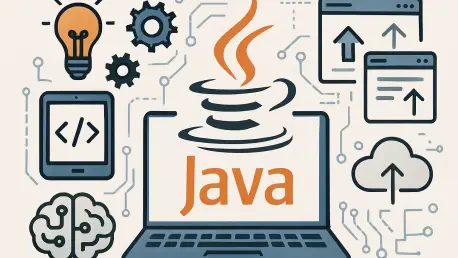I’m thrilled to sit down with Chloe Maraina, a Business Intelligence expert with a keen eye for data-driven storytelling and a deep passion for technology. With her extensive background in data science and a forward-looking perspective on software development, Chloe brings a unique lens to the latest advancements in Java. Today, we’re diving into the exciting updates in Java 25, the newest long-term support release of the JDK. Our conversation explores how these features simplify coding, enhance flexibility, and boost performance for developers, while also touching on practical applications and potential challenges.
What stands out to you as the most exciting new features in Java 25?
Java 25 is packed with updates that make development smoother and more intuitive. I’m particularly thrilled about JEP 512, which simplifies source files and introduces instance main methods. It strips away unnecessary complexity for beginners with a cleaner “Hello World” program. Then there’s JEP 513 for flexible constructor bodies—finally, we can run initialization code before calling super(), which is a game-changer for subclass handling. Also, scoped values from JEP 506 offer a smarter way to manage data with virtual threads. These features collectively push Java toward being more approachable and efficient.
Why do you think Java 25 being the latest long-term support release matters so much for developers?
An LTS release like Java 25 is a big deal because it provides a stable foundation for developers and organizations to build on for years. It means you get extended support, security updates, and bug fixes without the pressure to upgrade immediately to newer, non-LTS versions. For businesses running critical applications, this stability is crucial—it reduces risk and ensures compatibility. Plus, with all the innovative features in Java 25, developers can adopt cutting-edge tools knowing they’re backed by long-term reliability.
How does Java 25 make the language more accessible for beginners and less wordy overall?
Java has historically been criticized for its verbose syntax, which can intimidate new developers. Java 25 tackles this head-on with features like JEP 512. By allowing a simple void main() without all the object-oriented boilerplate, it lowers the entry barrier. You don’t need to understand public, static, or class right away to print a message to the console. Additionally, the introduction of IO.println() instead of the longer System.out.println() cuts down on typing and eliminates the need for explicit imports since it’s in java.lang. These changes make Java feel more welcoming and streamlined.
Can you break down JEP 512 and how it transforms writing a basic Java program?
Absolutely. JEP 512, which covers compact source files and instance main methods, is all about simplifying the structure of a basic Java program. Traditionally, even a simple “Hello World” required a class declaration and a static main method with a specific signature. With JEP 512, you can just write void main() and get straight to the logic. It’s a huge shift because it removes the need for object-oriented syntax in small or learning-focused programs, letting developers focus on core concepts without getting bogged down by structure.
What’s the real advantage of skipping object-oriented syntax for something as simple as a “Hello World” in Java 25?
The advantage is primarily in education and onboarding. For someone new to programming, seeing a wall of keywords like public, static, and class can be overwhelming before they even grasp what a variable is. By allowing a bare-bones main() method, Java 25 lets beginners write functional code with minimal syntax. It’s less intimidating and helps them build confidence. For experienced developers, it’s also handy for quick scripts or prototypes where full class structures are overkill.
How does the new IO.println() method improve the developer experience compared to the classic System.out.println()?
The IO.println() method is a small but meaningful tweak. Unlike System.out.println(), which is nested under System and feels a bit clunky to type repeatedly, IO.println() is more concise and lives in the java.lang package, so there’s no need to import anything. It’s just cleaner and faster to use, especially for console output in simple programs. It reflects Java’s broader push to reduce unnecessary verbosity and make common tasks more intuitive for developers at all levels.
In what scenarios would you still opt for the traditional main method over the simplified version in Java 25?
While the simplified main() is great for small programs or learning, the traditional public static void main(String[] args) still has its place. For larger applications, you often need the full class structure to handle command-line arguments via the args parameter, manage visibility, or integrate with frameworks that expect the standard entry point. Also, in team environments or legacy codebases, sticking to the traditional syntax ensures consistency and compatibility. So, for anything beyond quick experiments or tutorials, I’d lean toward the classic approach.
What challenge does JEP 513, Flexible Constructor Bodies, address in Java 25?
JEP 513 tackles a long-standing rigidity in how constructors work. Before Java 25, if you needed to call super() or this() in a constructor, it had to be the very first statement—no exceptions. This forced developers into awkward workarounds, like using static methods to handle initialization logic before passing data to a superclass. Flexible Constructor Bodies remove that restriction, allowing you to run code before calling super() or this(), which makes constructor logic more natural and easier to read, especially in complex inheritance scenarios.
Can you describe how constructors were constrained before Java 25, particularly with super() or this() calls?
Prior to Java 25, the rule was strict: if you were calling super() or this() in a constructor, it had to be the first line of code. The compiler would even insert an implicit super() call if you didn’t specify one. This meant you couldn’t do any preprocessing or validation in the subclass constructor before initializing the superclass. For example, if you needed to calculate a value to pass to super(), you had to offload that logic to a static method, which often made the code clunky and less intuitive. It was a real pain point for developers working with inheritance.
How does the flexibility in constructors benefit developers when dealing with subclasses, like in a Shape and Rectangle scenario?
The flexibility in Java 25 is a lifesaver for subclasses. Take the Shape and Rectangle example: Shape might have a constructor that takes an area, and Rectangle needs to calculate that area from width and height. Before, you’d have to extract the calculation into a static method to use it in a super() call right at the start. Now, with JEP 513, you can validate dimensions and compute the area directly in the Rectangle constructor before calling super(area). It keeps the logic together, making the code more readable and aligned with the developer’s intent.
Are there any important rules or limitations to keep in mind when using flexible constructors in Java 25?
Yes, while flexible constructors give more freedom, there are still guardrails. For instance, you can’t access instance fields or methods that depend on the superclass being fully initialized before calling super(). This prevents subtle bugs where uninitialized state could cause issues. Also, the compiler still ensures that super() or this() is called exactly once in the constructor path, so you can’t skip or duplicate those calls. Developers need to be mindful of initialization order to avoid unexpected behavior, but these rules are there to maintain safety.
What does JEP 511, Module Import Declarations, bring to the table for developers in Java 25?
JEP 511 introduces the ability to import an entire module at once instead of listing out individual packages. This is a huge time-saver, especially when working with large libraries or frameworks where you might need multiple packages from the same module, like java.base. Instead of writing several import statements for java.util, java.util.function, and so on, you can just import the whole module with a single line. It cuts down on boilerplate and makes your code cleaner at the top.
How does importing an entire module save effort compared to importing specific packages one by one?
Importing a whole module is a massive efficiency boost when you’re dealing with a broad set of related packages. For instance, if you’re working on data processing and need various utilities from java.base, listing each package individually—or even using wildcard imports like java.util.* for multiple packages—can clutter your file and take time. With JEP 511, a single import java.base; pulls in everything from that module. It’s quicker to write, easier to maintain, and reduces the chance of missing a necessary package.
Can you share an example of when importing a whole module might lead to problems, such as package name conflicts?
Certainly. One potential issue with importing an entire module is name collisions. If a module contains packages with classes or types that have the same name as something else in your code or another imported module, the compiler won’t know which one to use. For example, if you import two modules that both have a class named Utils, you’ll run into ambiguity errors unless you explicitly resolve it by fully qualifying the class name or narrowing your imports. It’s a rare issue, but in large projects with many dependencies, it can trip you up if you’re not careful.
Under what circumstances would you recommend sticking to specific package imports instead of a full module import in Java 25?
I’d suggest using specific package imports when you’re working on a project where clarity and precision are critical, or when there’s a risk of name conflicts. If you only need a handful of classes from a module, importing just those packages—or even specific classes—makes your code’s dependencies explicit and easier to audit. It’s also safer in collaborative or legacy projects where broad imports could accidentally pull in unwanted or deprecated components. Basically, if you value control over convenience, stick to targeted imports.
What are scoped values in Java 25, and how do they compare to thread-local variables?
Scoped values, introduced in JEP 506, are a new way to handle data sharing in a specific context, especially with virtual threads. Unlike thread-local variables, which are tied to a thread for its entire lifetime and are mutable, scoped values are immutable and only exist for the duration of a specific method or block. You define a scoped value and bind it to a task with ScopedValue.where(), and it’s accessible only within that scope. This makes them lighter, safer, and more predictable than thread-locals, avoiding issues like unintended data persistence across threads.
Why are scoped values especially valuable when working with virtual threads?
Virtual threads, which are lightweight and can number in the thousands, expose the limitations of thread-local variables. Thread-locals are shared across all virtual threads running on the same carrier thread, which can lead to data leakage or confusion. Scoped values solve this by being confined to a specific execution context, not a thread’s lifetime. They’re efficient for high-concurrency scenarios because they don’t carry overhead across unrelated tasks, and their immutability prevents accidental modifications. It’s a perfect fit for modern, scalable applications.
Could you provide an example of how scoped values might be used in a web application?
Sure. In a web app, you often need to store user-specific data, like authentication details, for the duration of a request. With scoped values, you can bind something like a user ID or session token to a scoped value at the start of request processing. For instance, using ScopedValue.where(USER_ID, currentUserId).run(() -> { ... }), any code inside that block can access USER_ID.get() without worrying about thread interference. Once the request is done, the value disappears—no lingering data, no cleanup needed. It’s clean and secure for handling per-request context.
What is your forecast for the future of Java development with these advancements in Java 25?
I’m optimistic about Java’s trajectory with releases like Java 25. The focus on simplicity, like with instance main methods and flexible constructors, signals a commitment to making Java more accessible without sacrificing its power for enterprise applications. Features like scoped values and enhancements to virtual threads show that Java is adapting to modern challenges like concurrency and scalability in cloud environments. I expect future releases to build on this, perhaps unifying primitives and objects under Project Valhalla, and continuing to refine performance with tools like generational garbage collection. Java’s staying relevant by balancing innovation with stability, and I think it’ll remain a go-to language for diverse use cases.









